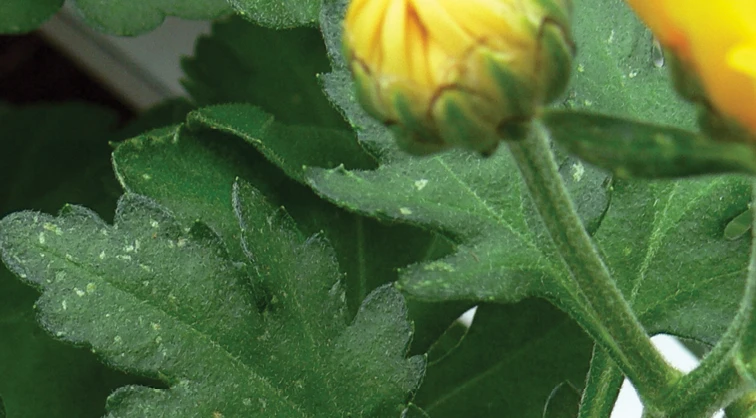As chrysanthemum growing and selling season picks up, growers need to ensure they are preventing insect pest and disease issues, and if they get them, properly treating them. Some of the insects that tend to complicate mum production are thrips and mites, while there are a variety of foliar diseases that can be problematic to mums such as fungal and bacterial leaf spots and Botrytis, says Mark Brotherton, portfolio leader at SePRO.
To prevent diseases and insect pests from becoming an issue on mums, Brotherton says it is important to “start clean, stay clean.” “With all the cuttings you receive, do your due diligence scouting as much as you feasibly can because it will likely save you in the long run. If needed, make an application early to eliminate anything that may be there,” he says. Numerous products can also help growers succeed in this area.
Fighting foliar diseases
A grower may unknowingly purchase contaminated cuttings or young plants, resulting in a disease outbreak in their mum crops. In addition, young plants can be particularly susceptible to foliar diseases, as they establish strong root systems, Brotherton says.
While young plants need regular watering, conditions that are too wet can be a breeding ground for diseases, Bortherton says. Growers can reduce the potential of foliar diseases on mums by reducing the length of time leaves maintain surface moisture. Many growers grow mums outside, and in situations where it is hot and there is a lot of rainfall, they can get Pythium, he says.

A common practice is to apply a preventative drench early to help prevent soil-borne diseases, Brotherton says. Mefenoxam and Etridiazole are reliable products growers can use as a preventative drench. For treating bacterial diseases, growers can rely on Camelot® O Fungicide/Bactericide from SePRO; and for Botrytis, they can use SePRO’s Decree Fungicide, which contains the active ingredient fenhexamid. Both solutions have excellent crop safety to mums and other flowers in bloom, he says.
Good IPM practice is to quarantine infected plants and also a buffer of plants around it to prevent the disease from further spreading, Brotherton says. “It is best to take at least two plants surrounding an infected plant and treat them if the disease is manageable or discard the plants altogether if they will no longer be marketable,” he says. Preventative applications will also significantly reduce disease outbreaks, he says.
Preventing and controlling thrips and mites
Joe Kurilich, senior grower at Neal Mast & Son Greenhouses’ Farm location, oversees nine acres of undercover production space and five acres of outdoor space. Much of the production, he says, is garden mums. Kurilich says he sees more insect pest than disease issues on mums. “Probably the biggest two pests for us are mites and thrips,” he says. “Once in a while, we have aphids, but the biggest ones are thrips and mites.”
Hachi-Hachi SC, an insecticide from SePRO that contains tolfenpyrad, provides preventative insect control for Neal Mast. (Kurilich also uses SePRO’s Topflor® Plant Growth Regulator on mums, which he says causes less delay in flowering than some other PGRs.)

Insect pest hot spots do pop up, and when they do, Kurilich practices good IPM by rotating chemistries. “When we get hot spots, we won’t spray the whole crop,” he says. “We’ll just spray where that higher activity is.”
Mites thrive in hot and dry conditions, so they are a common nuisance in the summertime, Brotherton says. For mite control, he says the SePRO’s Akari Miticide/Insecticide, which contains fenpyroximate, is a useful tool.
There are a couple reasons thrips and mites can swarm to mums in the summertime, Brotherton says. One is that many farmers are harvesting traditional ag crops, and insect pests migrate to find something new to feed on. (Weeds can also serve as host plants for insect pests, Brotherton adds, so keeping weeds away from operations will help growers considerably.) Insect pests also migrate to mums because many growers produce mums, and regularly water and fertilize them, during the summer, so insect pests are attracted to these crops and other production ornamentals.
Whether growers are trying to avoid or treat insect pest or disease issues, maintaining sanitation throughout the entire production cycle is key, Brotherton says. “If you eliminate all your insect and disease problems early, it makes life easier throughout production,” he says.
*Always read and follow label directions. Camelot® O and Topflor® are registered trademark of SePRO Corporation. Akari and Hachi-Hachi SC are registered trademarks of Nichino America, Inc.
Top photo: Thrips feed on plants by puncturing cells and sucking up cell content with their rasping-sucking mouthparts. Photo courtesy of Mark Brotherton






